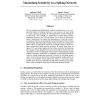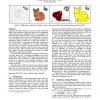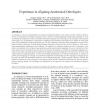1002 search results - page 198 / 201 » Reasoning about Object Structures Using Ownership |
NIPS
2004
13 years 11 months ago
2004
We use unsupervised probabilistic machine learning ideas to try to explain the kinds of learning observed in real neurons, the goal being to connect abstract principles of self-or...
CORR
2010
Springer
13 years 10 months ago
2010
Springer
Abstract. Orc is a theory of orchestration of services that allows structured programming of distributed and timed computations. Several formal semantics have been proposed for Orc...
NPAR
2004
ACM
14 years 3 months ago
2004
ACM
Algorithms that detect silhouettes, creases, and other edge based features often perform per-edge and per-face mesh computations using global adjacency information. These are unsu...
OOPSLA
2004
Springer
14 years 3 months ago
2004
Springer
Radio Frequency Identification (RFID) technology provides the means to track any object, any time, anywhere with Electronic Product Codes (EPC). A major consequence of this techno...
IJSWIS
2007
13 years 9 months ago
2007
An ontology is a formal representation of a domain modeling the entities in the domain and their relations. When a domain is represented by multiple ontologies, there is need for ...



